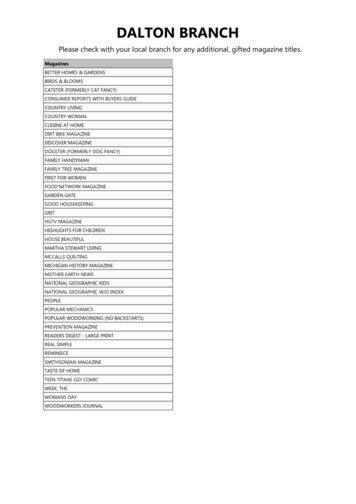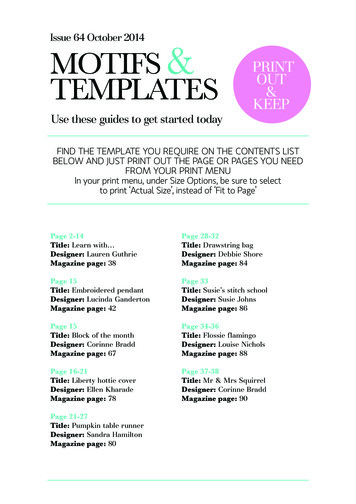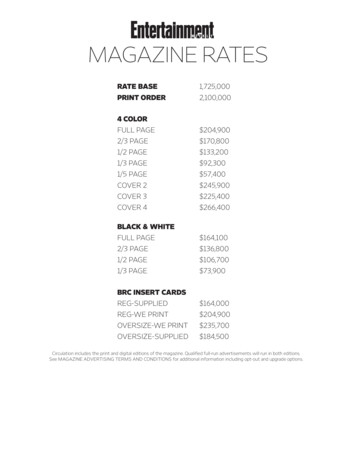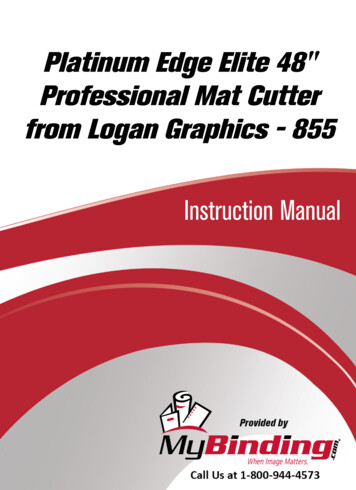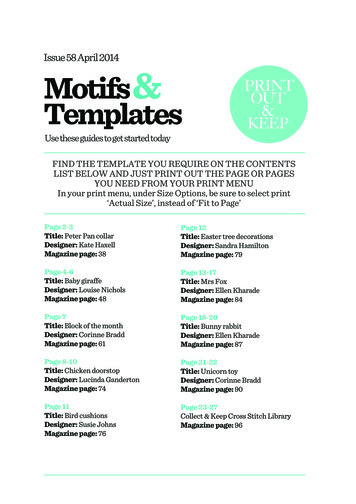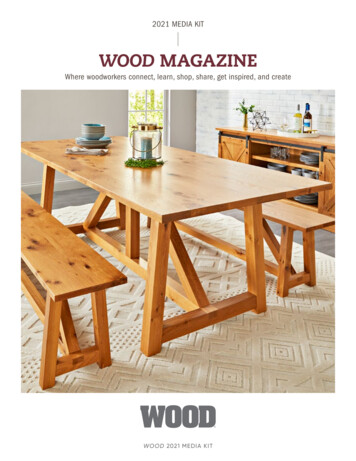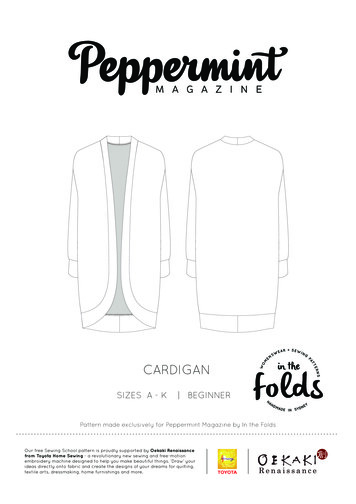
Transcription
CARDIGANSIZES A - K BEGINNERPattern made exclusively for Peppermint Magazine by In the FoldsOur free Sewing School pattern is proudly supported by Oekaki Renaissancefrom Toyota Home Sewing - a revolutionary new sewing and free-motionembroidery machine designed to help you make beautiful things. ‘Draw’ yourideas directly onto fabric and create the designs of your dreams for quilting,textile arts, dressmaking, home furnishings and more.
contentsAbout In the Folds patterns3Garment overview (details suggested fabrics)4Sizing garment measurements5Printing the pattern6Printing plan7Sewing with knits8Fabric requirements suggested cutting plans9 - 10Instructions11-16Glossary17
about in the folds patternsSLOW SEWINGIn the Folds patterns are designed to enableyou to create beautiful and innovative garments,as well as encourage interesting andthought-provoking learning experiences.In the Folds patterns are designed to includethoughtful details and interesting techniquesso that you can enjoy the process of makingthe garment as much as the end result.Techniques may differ slightly to the home sewing methods you are used to, but in some casesindustrial finishes will give you the cleanest andmost professional finish. Due to this, seam allowances vary. Seam allowances are highlightedin each step, but can also be found below.If we slow down and take in every stitch, we canbetter our skills, appreciate the amazing thingswe can do with our hands, understand the process more fully and create garments that will beworn, loved and cared for long into the future.THE ENVIRONMENTWe'd love to see your work in progress.Please consider the environment beforeprinting this instruction booklet.Find us on Instagram @inthefolds and@peppermintmagazine and tag your photoswith #peppermintsewingschoolAlso consider using fabric from your stashbefore going to buy something new. I dare you.You might be surprised by what you find there.Before selecting your fabric, really think abouthow this garment will fit into your wardrobeand how you plan to care for it. Choose a fabricthat fits the bill.Happy sewing!3
garment overviewFRONTGARMENT DETAILSThis Cardigan is a knee-length slouchycardigan, with wrap around collar / hem bandand sleeve cuffs. It has a relaxed fit, perfectfor autumn / winter layering and has in-seampockets, for a really cosy feel.Through the creation of this garment you willgain confidence in:- sewing with knit fabrics- sewing straight seams- sewing curved seams- sewing in-seam pocketsFABRIC SUGGESTIONSThis cardigan is designed to be sewn withlight to mid-weight knit fabrics with at least20% stretch. For more details on how tocheck the stretch content of your fabric go top. 8.BACKConsider using: French terry, sweater fleeceor jersey.NOTIONS 4Fabric (yardage on p. 5)Coordinating thread
sizing garment measurementsBODYMEASUREMENTSAABBCCDDE EF FG GHHJJKKHIGH m49½”FULL ½”116cm45½”FINISHED GARMENTMEASUREMENTSABCDEFGHJKBUST97cm38⅛ ”102cm40⅛ ”107cm42⅛ ”112cm44⅛ ”117cm46⅛ ”122cm48⅛ ”129.5 cm50⅞ ”137.0 cm53⅞ ”144.5 cm56⅞ ”152.0 cm59⅞ ”WAIST101cm39¾ ”106cm41¾ ”111cm43¾ ”116cm45¾ ”121cm47¾ ”126cm49¾ ”133.5 cm52½ ”141cm55½ ”148.5cm58½ ”156cm61½ ”HIP103cm40½ ”108cm42½ ”113cm44½ ”118cm46½ ”123cm48½ ”128cm50½ ”135.5 cm53¼ ”143cm56¼ ”150.5 cm59¼ ”158cm62¼ ”FINISHED LENGTH91.4 cm36 ”92cm36¼ ”92.6 cm36½ ”93.2 cm36¾ ”93.8 cm36⅞ ”94.4 cm37⅛ ”95cm37⅜ ”95.6 cm37⅝ ”96.2 cm37⅞ ”96.8 cm38⅛ ”(centre back neck to hem)FABRICREQUIREMENTS *A115cm45”2.5 yds150cm60”1.8 yds2.3 m1.5 mB2.3 m2.5 yds1.6 m1.8 ydsC2.4 m2.6 yds1.6 m1.8 ydsDE2.4 m2.5 mF2.5 m2.6 yds2.7 yds2.7 yds1.7 m1.8 m1.8 m1.9 yds2 ydsTaking your measurements:If your measurements fall between sizes, use thefinished measurements to help you select yoursize.If your measurements range between severalsizes, print the sizes your measurements liebetween and grade between the sizes bydrawing diagonal lines from one size to another.The pattern is drafted for height of 170cm (5’7”).There are ‘Lengthen / Shorten’ lines on thepattern that you can use if you would like toadjust the length of the garment.*Please note : If you are using fabric with a directional print, it is likely you will require morefabric than suggested.52 ydsG2.6 m2.9 yds2m2.2 ydsH2.6 m2.9 yds2.1 m2.3 ydsJ2.7 m3.0 yds2.2 m2.4 ydsK2.8 m3.1 yds2.3 m2.5 yds
printing the patternPAPER SIZEPRINTThis pattern can be printed on both A4 or USletter-sized paper. There is also a full sizedversion included so that, if you’d prefer, youcan get it printed in full sheets (2 x A0) atyour local copy shop.When you have the scaling right, print theremainder of the pattern.ASSEMBLECut around the border of each page - onelong side and one short side (keep yourchoice of sides consistent between pages).Align the circles so that 1A matches up to1A, 2A with 2A etc, and tape or glue in place.Use the printing plan on p. 7 as a reference,if required.LAYERSThis pattern has embedded layers. Thismeans that you can select only the size/s youwould like to print.Layers make it much less confusing to cutout the pattern, and also saves on ink (andpaper in some cases).Open the pattern in AdobeReader and click on the ‘layers’option on the left hand side.There will be an eye next toeach layer in the pattern. Turnoff (by clicking) all the layers youdo not need. Please note, at thetime of publishing, layers are notavailable on Preview (Mac). Youwill need to install Adobe Readerto access this feature.The ‘PATTERN INFO’ layer needs to be onfor all sizes.SCALINGOpen the pattern in Adobe Reader. Beforeprinting the file, you will need to check thescaling settings on your printer. The patternneeds to be printed at its true scale. To dothis, go into your print settings and select‘actual size’ or set page scaling to ‘none’ or‘turn off page scaling.’Print only Page 1 of the pattern, and checkthat the large test square measures 5cmx 5cm, or the smaller one measures 1in x1in. It really needs to be precise, so if it isnot quite right, you will need to go back andcheck your printer settings again.6
printing plan350F0FALL SIZES1 236CUT 2 PAIRSYou can also look to p. 7, to find outwhat pages you need to print foryour size and style.CARDIGANThis means that you can selectonly the size/s you would like toprint. Look to p. 5 of the instructionbooklet for more details.POCKET BAG5cm x 5cmDid you know this sewing patternhas layers?1B1 inch x 1 inch1BTEST SQUARE2F2B2C3CLENGTHEN / SHORTEN LINE3C3A3AGrainline2C2F2B3 4 5 67 8 9 1037CARDIGANSEWING PATTERN3B3BFEEL FREE TO HACK THIS PATTERN,ADD TO THIS PATTERN, LOVE THIS PATTERNAND TO MAKE IT OVER & OVERBUT PLEASE REMEMBER THAT IT’SFOR PERSONAL USE ONLYHAPPY SEWING!CEmily HundtPATTERN SIZE KEYSIZE ASIZE BSIZE CSIZE DSIZE ESIZE FSIZE GSIZE HSIZE JSIZE KCARDIGAN4B4C4D4F4D4C4BSLEEVE4A4FOur free Sewing School pattern is proudly supportedby Oekaki Renaissance from Toyota Home Sewing - arevolutionary new sewing and free-motion embroiderymachine designed to help you make make beautifulthings. ‘Draw’ your ideas directly onto fabric andcreate the designs of your dreams for quilting, textilearts, dressmaking, home furnishings and more.4ACUT 1 PAIR5C5B5C5B5A5ALENGTHEN / SHORTEN LINEPATTERN SYMBOL KEYnotch38double notch(indicates the back of the pattern piece)drill holecutting linestitch linegrainlineplace pattern on foldGrainlinelengthen / shorten linedirection to fold pleatSHARE YOUR MAKES#peppermintsewandtellTag T ALONG LINE TO MAKE PATTERN MORE MANAGEABLE TO ASSEMBLE7D7C7B7AGrainline11 12 13 14 15 D9C9B9A9ACUT 1 PAIR17 18 19 20 21 22CARDIGANNECK BANDCUT 1 PAIRLENGTHEN / SHORTEN LINELENGTHEN / SHORTEN LINE10C10BCentre back (place on 11B11CGrainlineCUT 1 ON FOLD11A11E11D11C11B11A2324252627 13C13B12A13A13A12D12E12B12F12A293031 3233 34FOLD LINECARDIGANCUT 1 PAIRGrainlineSLEEVE CUFFNote:This pattern has layers, whichmeans you can just print the size/syou need. Be sure to keep the‘PATTERN INFO’ layer on, as thislayer includes all cutting informationetc.REQUIRED PAGESSIZEPages to printAp. 1-2, p. 4-5, p. 8-9,p. 11-26, p. 29-38B/Cp. 1-6, p. 8-9,p. 11-26, p. 29-38Dp. 1-26, p. 29-38E-Kall pages7For some sizes, you do not needto print all pages. Use this table todetermine which pages you need toprint for your size.
sewing with knitsThis pattern has been designed to be usedin conjunction with mid weight knits with atleast 20% stretch.USING AN OVERLOCKERIf you are using an overlocker (serger) toassemble your garment there is no needto sew your seams together with a sewingmachine first. Stitch your seams with youroverlocker, ensuring your stitch width is nolarger than the 6mm (¼in) seam allowance.TESTING STRETCH INKNIT FABRICSCut a square from your fabric 10cm x 10cmavoiding the selvedge. With the stretchrunning from side-to-side, stretch yourfabric as far as you can comfortably, beingsure not to overstretch it, and measure. Ifthe fabric stretches to 12cm (or more) it issuitable for this pattern.USING A SEWING MACHINEIf you are using a standard sewing machineto make your garment, use a stretch stitch(available on some sewing machines) or anarrow zig zag stitch. This will ensure thatyour stitches don’t break when the garmentis stretched. Finish seams with a standardzig zag stitch if you like.CUTTING YOUR FABRICTake your pre-washed fabric and fold it inhalf lengthways, with right sides together.Bring the selvedges together and smoothout any wrinkles. By folding the fabric in half,you will be able to cut two pieces at the sametime.Use a ballpoint needle in your sewingmachine and normal thread. If the fabricis stretching too much or is too bulky,consider lessening the foot pressure orusing a walking foot.Take your pattern pieces and lay them onyour fabric, with the grainline of each patternpiece running exactly parallel to the selvedge.FITTINGIf a pattern asks for ‘CUT 1 ON FOLD’ - alignthe pattern piece with the fold of the fabric,so that you will be left with a full patternpiece once cut.If you would like to check the fit of yourcardigan, simply use a basting stitch (longstitch on your sewing machine) to assemblethe garment and then check the fit. Makenecessary adjustments and then stitchtogether with your sewing machine oroverlocker.Use weights and pins to hold the pieces inplace. Carefully cut out each piece. Be sure totransfer all pattern markings onto your fabric.PATTERN MARKINGSTo mark a notch, snip into the fabric3-4mm. If your fabric is delicate or proneto pulling, I suggest indicating your notcheswith a horizontal pin.8
fabric requirements suggested cutting plansSIZES A - FIf you are using a directional print,be careful to cut the pattern pieceso that the print is the right way up(this may require more fabric thansuggested). If you are planningon matching prints, you may alsorequire more fabric.652512FOLDSELVEDGESFOLDSELVEDGES163664115cm / 45in fabricPieces to cut :1 - Front - cut 1 pair2 - Back - cut 1 on fold3 - Neck band - cut 1 pair4 - Sleeve - cut 1 pair5 - Sleeve cuff - cut 1 pair6 - In-seam pocket - cut 2 pairs34150cm / 60in fabricTIPAlthough cutting on the fold is the fastest wayto cut your fabric, if you cut flat (fabric is notfolded) and cut each piece independently, youwill use less fabric.If you use this method, when cutting a pair,be sure to cut one piece with the pattern faceup, and then the other with the pattern facedown.9
SIZES G - KIf you are using a directional print,be careful to cut the pattern pieceso that the print is the right way up(this may require more fabric thansuggested). If you are planningon matching prints, you may alsorequire more cm / 45in fabric150cm / 60in fabricPieces to cut :1 - Front - cut 1 pair2 - Back - cut 1 on fold3 - Neck band - cut 1 pair4 - Sleeve - cut 1 pair5 - Sleeve cuff - cut 1 pair6 - In-seam pocket - cut 2 pairs10TIPAlthough cutting on the fold is the fastest wayto cut your fabric, if you cut flat (fabric is notfolded) and cut each piece independently, youwill use less fabric.If you use this method, when cutting a pair,be sure to cut one piece with the pattern faceup, and then the other with the pattern facedown.
sewing time!Fabric Right sideAll seam allowances are 6mm (¼in).1Fabric Wrong sideStep 1:Take the pair of FRONT [1] pieces and placethem right side up. Take one pair of IN-SEAMPOCKET [6] pieces and place right side downon the side seam of each front piece - placingeach pocket between the two notches. Pin inposition.16Illustration key:6Stitch in place.Note: You may want to check the pocketposition before sewing it in place. To do this,hold one of your front pieces up to yourbody, with the shoulder seam 6mm (¼in)beyond your shoulder line and check if thepocket is in a comfortable position.2Step 2:Take the BACK [2] piece and other set ofIN-SEAM POCKET [6] pieces and positionbetween notches. Pin and stitch in place.66Press both sets of in-seam pockets awayfrom the piece it is attached to.11
21Step 3:With right sides together, pin the front andback shoulder seams together on each side.1Stitch shoulder seams.661Press seams towards the back of thecardigan.Step 4:Lay the body of the cardigan out flat (withright side up) - flattening the shoulder seams.Take the SLEEVE [4] and pin the sleeve headinto the armhole, with right sides together,using the notches to guide you.41Stitch in place and press seam towards bodyof the cardigan.Repeat for the other sleeve.2Step 5:With right sides together, pin theunderseams of the sleeve together andthen work your way down the side seam(and around the pocket edge).Repeat for the other side.Stitch seams.12
FRONT3 cmBACKStep 6:To ensure the pockets remain on the insideof the garment (and you get a nice smoothside seam) take a ruler and draw a line thatcontinues the side seam into the pocket- 3cm (1¼in) from the top of the pocketand 3cm (1¼in) from the bottom. Markendpoints with a horizontal pin.63 cmSLEEVEFRONT6Step 7:Using your sewing machine, carefully stitchalong each line, being sure to check that theseam allowance on the underside is out ofthe way.Step 8:Turn the cardigan right side out and give ita good press (pressing the pocket and sideseams towards the front of the garment).13
3Step 9:Take the NECK BAND [3] and match the shortends together, with right sides together,creating a long continuous loop.Stitch each seam and press to one side.33Step 10:Fold the NECK BAND [3] in half lengthways,with wrong sides together. Carefully workyour way around the loop, pressing the fold.441Step 11:Pin NECK BAND [3] to the cardigan by pinningthe raw edges of the band to the raw edge ofthe cardigan, with right sides together. Startby matching the seam on the narrow end ofthe neck band to the notch in the centre backneck. Carefully work your way around thewhole band, using the notches to help youdistribute the neck band evenly.12Stitch seam (checking that the side seamsremain pressed towards the front of thegarment).3314
Step 12:With the cardigan inside out, press the seamallowance towards the body of the cardigan.Turn to the right side and now give the seama good press from the right side, to ensurethe band is sitting nice and flat.Optional: You can topstitch the neck bandin place if you like (by stitching close to theseam on the cardigan - catching the seamallowance on the inside).5Step 13:Take the SLEEVE CUFF [5] pieces and foldin line lengthways (along the grain), withright sides together, pinning the raw edgestogether.5Stitch and press seams to one side.5Step 14:Fold SLEEVE CUFFS [5] in half, with wrongsides together.515
45FRONTStep 15:Pin SLEEVE CUFF [5] to SLEEVE [4] - using thenotches to help you evenly distribute it. Youwill need to stretch the sleeve cuff slightly tomake it fit.Repeat on other side and stitch in place.CK BANDNECK BANDE45Step 16:Flip the cuffs to the right side and press theseam up towards the sleeve (a sleeve hamwill help with this if you have one).Give your cardigan and a good press andyou’re all done!NECK BAND16
glossaryBASTE - Sew temporary stitches to hold pieces in place before sewing permanently. Basting can be done by hand or machine (on a long stitch length). Consider using a contrastthread when basting to make stitches easier to remove later.CLIP - Snip into the seam allowance (perpendicular to the raw edge) getting close to thestitch line, to help open up curved seams or corners.DRILL HOLE - Drill holes are small holes marked on a pattern, often used to indicate a dartpoint or other design features, such as the location of patch pockets, belt loops or pivotpoints (any feature that is located in an area where you are unable to notch a seam).FINISH - Neaten the raw edges of your project using an overlocker, zigzag stitch or binding.GRADE SEAM ALLOWANCES - Minimise bulk by trimming down raw edges in varyingwidths. Trim down the seam allowance that will sit closest to the body close to the stitchline. Trim the next layer, leaving a slightly wider seam allowance than the first, and so onuntil all layers are trimmed back.INTERFACING - A (normally) fusible fabric that is used to stiffen or strengthen fabric, incertain parts of a garment. It is often used in collars, cuffs and button plackets.NOTCH - A notch is a small cut in the fabric that helps guide you while you are sewing.It can be used to indicate seam allowance, dart arms, the location of design details orindicate key points on the pattern (like the centre front or centre back). Notches are alsoused to indicate balance points (points on your pattern that help you sew the right piecestogether, as well as help you when you are sewing long or curved seams).PRESS - Use a hot iron to press seams flat, using steam (if appropriate for your fabric).RIGHT SIDE / WRONG SIDE - The right side of the fabric is the side you would like to seeon the outside of the finished garment, while the wrong side is the side that will be hiddeninside the garment.SEAM ALLOWANCE - The space between the stitching line and the raw edge of the fabric.The seam allowance varies throughout this pattern, depending on the seam. For example,larger seam allowances are required for centre back and side seams, while smaller seamallowances are required for curved seams so that you can achieve a clean finish.STAY STITCH - "Staystitching" is a line of stitching inside the permanent stitch line (so itremains hidden inside the seam allowances) that is used to reinforce curved and bias cutseams, so that they do not stretch or distort during the sewing process.TRIM - Cut back a seam allowance to make a seam easier to manage or less bulky.UNDERSTITCH - Stitch the seam allowance to a facing or binding, close to the seam edge.This helps the facing (or binding) roll to the inside of the garment, preventing it from beingseen on the outside of a garment.17
Woohoo, you have finished your cardigan!We’d love to see what you made!Find us on Instagram @peppermintmagazine and @inthefoldsand tag your new skirt with #peppermintsewingschoolLove the pattern?Plenty more patterns can be found atwww.peppermintmag.com/other/sewing-school/ www.inthefolds.comPattern is for individual use onlyYou can make the garment for yourself or as a gift. It does not entitle you to print, copy or distribute the pattern toothers, whether you profit from it or not, nor to sell garments thatyou have made from this sewing pattern.Thank you for respecting the rights of the designer.CEmily Hundt 2017 - made with love in Sydney, Australia for Peppermint MagazineOur free Sewing School pattern is proudly supported by Oekaki Renaissancefrom Toyota Home Sewing - a revolutionary new sewing and free-motionembroidery machine designed to help you make beautiful things. ‘Draw’ yourideas directly onto fabric and create the designs of your dreams for quilting,textile arts, dressmaking, home furnishings and more.
- sewing with knit fabrics - sewing straight seams - sewing curved seams - sewing in-seam pockets FABRIC SUGGESTIONS This cardigan is designed to be sewn with light to mid-weight knit fabrics with at least 20% stretch. For more details on how to check the stretch content of your fabric go to

